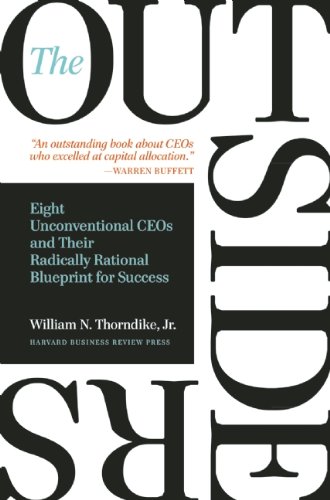

This article is an excerpt from the Shortform summary of "The Outsiders" by William N. Thorndike, Jr. Shortform has the world's best summaries of books you should be reading.
Like this article? Sign up for a free trial here .
Why was William Anders’ (Bill Anders) work as CEO of General Dynamics Corporation so impactful? What strategies did he employ to make growth possible?
William Anders is a former fighter pilot and astronaut. Anders joined General Dynamics to offer a new perspective on the defense company’s tactics following the end of the Cold War. Anders immediately worked to scale back operations, and find ways to grow the company’s value.
Learn Bill Anders’ key business strategies at General Dynamics.
Bill Anders’ Strategy: Key Ideas
Bill Anders’ strategy for General Dynamics had three key ideas:
- The company would only stay in businesses where it could be #1 and #2 (a famous Jack Welch idea).
- The company would leave commodity businesses with low returns.
- The company would stick to its strengths. Namely, it would leave commercial businesses and stick to defense and government contracts.
In his three years as CEO, Bill Anders implemented a rigorous focus on margins and generating more cash:
- He found that the mindset of the company was to make bigger, faster weapons to grow revenue, with little care for shareholders and financial performance. He moved to instill a new mindset of financial performance, emphasizing cash return on capital.
- He made large personnel adjustments. He replaced 21 of the top 25 executives, reduced headcount by 60%, and cut corporate staff by 80%.
- He promoted Jim Mellor, a business unit head known for enforcing results, to COO.
- He and Mellor tightened operations by reducing inventory and capital equipment. They found a systemic problem of excess inventory (for instance, having dozens of F-16 plane canopies in a facility that made just one plane a week) as well as duplicate machinery.
These moves produced fantastic returns—$2.5 billion in cash, and a market-leading return on assets.
The other major move Bill Anders employed was selling non-core businesses to other defense companies. He found that competitors were willing to pay premium prices to grow their businesses. Within two years, Anders sold the majority of their business lines, including their F-16 fighter plane division to Lockheed for $1.5 billion. This was unprecedented in the defense industry—observers say Anders was only able to do this because of his credibility in Washington as a military veteran. These sales generated another $2.5 billion in cash.
What to do with this extra $5 billion in cash? Bill Anders made two moves:
- He paid special dividends to shareholders worth about half of the company’s market capitalization. Even better, because they came from the sale of business units, they were deemed “return of capital” and weren’t taxed as capital gains or ordinary income.
- He used $1 billion to repurchase 30% of company shares.
All of these moves—the generation of billions in cash, and its return to shareholders—made the stock price of General Dynamics shoot up.
After serving as 3 years as CEO, William Anders handed the reins to his COO, Jim Mellor.
Shareholder Value as Top Priority
Many CEOs let ego drive their strategy, growing revenue and headcount with little concern for profits.
It takes an egoless CEO to actively shrink the company for the sake of shareholder value. In a time when defense companies were scrambling to acquire other businesses to grow, Bill Anders actively shed the majority of the business units at General Dynamics.
These were not easy decisions—a former pilot, he had a special soft spot for the F-16 fighter jet division. But when Lockheed made an offer for the right price, he did it without hesitation.
Flexible Strategy
Outsider CEOs tended to avoid concrete strategic plans, instead preferring flexibility to adjust to the circumstances.
When Bill Anders was actively selling businesses, he had actually intended to grow the fighter jet business through acquisition. He approached Lockheed’s CEO with the intent to buy their business, and was surprised when Lockheed instead countered with a generous offer to buy General Dynamics’s F-16 business. Had Anders been more stubborn about retaining the business, he might have missed this opportunity.
Likewise, a company needs different strategies in different situations. Bill Anders grew the company’s value by aggressively shedding its non-core businesses and shrinking the company through improved operations. Just 6 years later, Chabraja grew the business lines through thoughtful acquisitions, including the massive bet on Gulfstream. Even more notably, he did so by selling stock, a rare move among outsider CEOs but appropriate at the time given that their stock was at an all-time high.
Decentralization
Companies in the defense industry are often run by military veterans, so it’s no surprise that they tend to be hierarchical, centralized, and run from the top-down, just like the military.
However, Bill Anders and his two successors pushed continuously for decentralization. They shrunk headquarters and middle management by over 75% and shifted responsibility downward to the business units. There was active dissuasion of headquarters meddling with operating divisions. As is typical in outsider CEO companies, if the division chiefs hit their budgets, they were left alone.
As part of its decentralization strategy, General Dynamics instituted bonus compensation based on long-term improvements in stock price. This was key to attracting capable talent to the company.
It’s possible that Bill Anders’ astronaut days helped him gain a sharp eye and decision making skills. Bill Anders was the CEO of General Dynamics for three years, before handing the reigns to his COO, Jim Mellor. Mellow implemented his own strategies, but kept in place the core values of the company that Anders had established, further pursuing company growth.

———End of Preview———
Like what you just read? Read the rest of the world's best summary of William N. Thorndike, Jr's "The Outsiders" at Shortform .
Here's what you'll find in our full The Outsiders summary :
- What great CEOs like Warren Buffett do that average CEOs don't
- How to master the art of capital allocation
- How to be a great manager that your team is excited to work with






